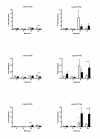Highly pathogenic or low pathogenic avian influenza virus subtype H7N1 infection in chicken lungs: small differences in general acute responses
- PMID: 21314972
- PMCID: PMC3037890
- DOI: 10.1186/1297-9716-42-10
Highly pathogenic or low pathogenic avian influenza virus subtype H7N1 infection in chicken lungs: small differences in general acute responses
Abstract
Avian influenza virus can be divided into two groups, highly pathogenic avian influenza virus (HPAI) and low pathogenic avian influenza virus (LPAI) based on their difference in virulence. To investigate if the difference in clinical outcome between LPAI and HPAI in chickens is due to immunological host responses in the lung within the first 24 hours post infection (hpi), chickens were infected with LPAI or HPAI of subtype H7N1. Virus was found in the caudal and cranial part of the lung. With LPAI, virus was localised around the intrapulmonary bronchus and secondary bronchi. In sharp contrast, HPAI was detected throughout the whole lung. However, based on viral RNA levels, no quantitative difference was observed between LPAI and HPAI infected birds. In infected areas of the lungs, an influx of CD8α+ cells as well as KUL01+ macrophages and dendritic cells (DC) occurred as fast as 8 hpi in both infected groups. No major difference between LPAI and HPAI infected birds in the induction of cytokines and interferons at mRNA level in lung tissue was found.In conclusion, the differences in lethality for chickens infected with LPAI or HPAI could be ascribed to difference in location of the virus. However similar amounts of viral RNA, similar cytokine mRNA levels, and similar influxes of CD8α+ and KUL01+ macrophages and DC were found between HPAI and LPAI in the lungs. A cytokine storm at mRNA level as described for mammals was not observed in the lungs of HPAI infected birds within 24 hpi.
Figures






References
-
- Li KS, Guan Y, Wang J, Smith GJ, Xu KM, Duan L, Rahardjo AP, Puthavathana P, Buranathai C, Nguyen TD, Estoepangestie AT, Chaisingh A, Auewarakul P, Long HT, Hanh NT, Webby RJ, Poon LL, Chen H, Shortridge KF, Yuen KY, Webster RG, Peiris JS. Genesis of a highly pathogenic and potentially pandemic H5N1 influenza virus in eastern Asia. Nature. 2004;430:209–213. doi: 10.1038/nature02746. - DOI - PubMed
-
- de Jong MD, Simmons CP, Thanh TT, Hien VM, Smith GJ, Chau TN, Hoang DM, Chau NV, Khanh TH, Dong VC, Qui PT, Cam BV, Ha do Q, Guan Y, Peiris JS, Chinh NT, Hien TT, Farrar J. Fatal outcome of human influenza A (H5N1) is associated with high viral load and hypercytokinemia. Nat Med. 2006;12:1203–1207. doi: 10.1038/nm1477. - DOI - PMC - PubMed
-
- Lee N, Wong CK, Chan PK, Lun SW, Lui G, Wong B, Hui DS, Lam CW, Cockram CS, Choi KW, Yeung AC, Tang JW, Sung JJ. Hypercytokinemia and hyperactivation of phospho-p38 mitogen-activated protein kinase in severe human influenza A virus infection. Clin Infect Dis. 2007;45:723–731. doi: 10.1086/520981. - DOI - PubMed
Publication types
MeSH terms
Substances
LinkOut - more resources
Full Text Sources
Medical

